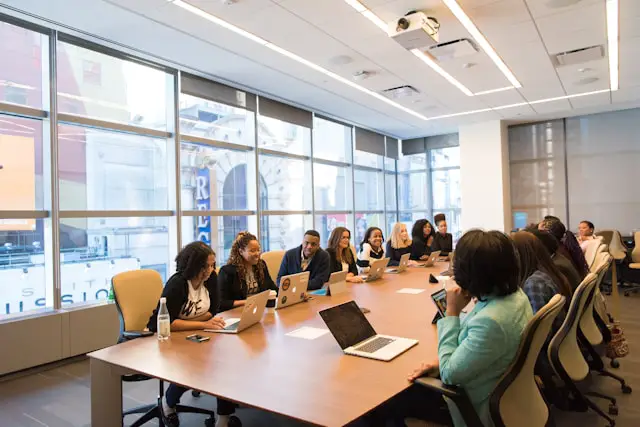
When groups come together to make decisions, the hope is that combining perspectives will lead to better outcomes.
However, this isn’t always the case. Sometimes, group dynamics can stifle critical thinking and lead to poor decisions—a phenomenon known as groupthink.
Understanding the psychology behind groupthink is essential to preventing it and fostering healthier, more effective collaboration.
What is Groupthink?
Groupthink happens when a group of people puts more value on maintaining harmony and agreeing with each other than on making well-thought-out decisions.
This often leads to poor outcomes because differing opinions are ignored, and other possible solutions aren’t fully considered.
The term was first introduced by social psychologist Irving Janis in 1972, and it highlights how the desire for group unity can sometimes cloud judgment and lead to mistakes.
When groupthink takes over, important issues may be overlooked, and the group may miss out on better ideas or solutions.
Why Does Groupthink Matter?
Groupthink has been behind some significant failures in history and business, such as the Bay of Pigs invasion and major corporate scandals.
Understanding the signs, causes, and ways to prevent groupthink is crucial for making better decisions.
By being aware of groupthink, teams can encourage open discussion, consider different viewpoints, and avoid making costly mistakes that might come from overlooking important details or ignoring alternative solutions.

The Symptoms of Groupthink
Groupthink is characterized by specific symptoms that indicate a group may be prioritizing consensus over critical thinking:
Illusion of invulnerability
When a group is affected by groupthink, it may feel overly confident and optimistic.
Members start to believe their decisions are foolproof, which can lead them to take unnecessary risks without considering the possible negative outcomes.
Collective rationalization
Instead of critically evaluating evidence that goes against the group’s decisions, members might dismiss it or try to justify their choices.
They convince themselves that their approach is right, even when there are warning signs or contradictions.
Belief in inherent morality
Groups influenced by groupthink often think their decisions are morally correct, which can cause them to ignore any ethical concerns.
This mindset can lead to actions that harm others or violate important values.
Stereotyped views of out-groups
The group may develop negative views of people outside the group, such as those who disagree or offer alternative perspectives.
This makes it harder to consider new ideas and reinforces the group’s existing biases.
Pressure for conformity
Members might feel pressure—whether subtle or direct—to agree with the majority.
This creates an atmosphere where speaking up or offering a different opinion feels risky, making people more likely to stay quiet instead of challenging ideas.
Self-censorship
To keep the peace, individuals within the group may choose not to voice their true thoughts or concerns.
Over time, this leads to fewer diverse viewpoints being heard and weakens the quality of decision-making.
Illusion of unanimity
When there are no dissenting voices, the group may believe that everyone agrees, even when they don’t.
This false sense of unity can strengthen poor decisions and make the group less likely to reconsider their choices.
Mindguards
Some group members may take on the role of “mindguards,” actively blocking opposing opinions or information that might challenge the group’s view.
This prevents critical feedback from being heard and can reinforce bad decisions.

The Causes of Groupthink
Several factors can lead to groupthink, where the desire for harmony and agreement within the group outweighs critical thinking and careful decision-making.
Here are the main causes:
High Group Cohesion
While strong teamwork and unity are generally positive, too much cohesion can lead to conformity.
When group members value the relationships within the group more than expressing differing opinions, they might suppress their concerns to maintain harmony.
Directive leadership
When a leader strongly pushes for a particular outcome, group members may feel pressured to agree with the leader’s views, even if they have reservations.
This can stifle creativity and prevent the group from exploring other options.
Isolation
Groups that don’t seek input from outside sources or viewpoints are more likely to fall into groupthink.
Without fresh perspectives, the group’s ideas and biases can go unchallenged, reinforcing poor decision-making.
Stressful situations
When a group faces high pressure or time constraints, members may rush to make decisions to relieve the stress.
This sense of urgency can discourage careful discussion and lead to hasty decisions driven more by the need to act quickly than by thoughtful deliberation.
The Consequences of Groupthink
Groupthink can have serious and long-lasting effects on a group and its decisions. Here are some of the main consequences:
Poor decision-making
When a group suppresses differing opinions and overlooks alternative options, it often leads to decisions that aren’t well thought out.
Important factors might be ignored, resulting in subpar outcomes.
Reduced creativity
Groupthink discourages new ideas and creative thinking.
Since everyone tends to align with the majority, there’s less room for diverse perspectives, which can limit innovation and problem-solving.
Ethical violations
The belief that the group’s decisions are morally right can lead to unethical choices.
The group may overlook potential harms or fail to consider the broader impact on others, causing harm to stakeholders or the public.
Eroded relationships
When people feel their opinions are ignored or dismissed, it can create frustration and resentment.
Over time, this damages trust and weakens the relationships within the group, making it harder to work together effectively.

Preventing Groupthink
While groupthink can have serious consequences, there are several ways to prevent it and ensure better decision-making.
Here are some strategies to help avoid groupthink:
Encourage open discussion
Create a safe space where everyone feels comfortable sharing their opinions.
Make it clear that differing views are valuable and necessary for good decision-making.
This allows everyone’s voice to be heard and considered.
Leader neutrality
Leaders should remain neutral during discussions to avoid unintentionally steering the group’s decisions.
When leaders don’t show a strong preference, it encourages members to express their honest thoughts without feeling pressured.
Devil’s advocate
Assign someone to take on the role of “devil’s advocate”—someone who challenges ideas and assumptions.
This helps the group consider different viewpoints and spot potential flaws in their reasoning before making a decision.
Seek outside input
Bringing in perspectives from outside the group can help counteract biases and offer new ideas.
This is especially important when making complex or high-stakes decisions, as external input can offer fresh insights and alternative solutions.
Break into smaller groups
Divide the larger group into smaller teams for brainstorming.
Working in smaller groups allows members to think more freely and come up with a wider range of ideas.
The teams can then come together to discuss and evaluate the ideas.

Final Thoughts
Groupthink is a powerful force that can undermine even the most talented teams.
By recognizing its symptoms and addressing its causes, groups can foster a culture of open dialogue, critical thinking, and innovation.
Preventing groupthink isn’t just about improving decision-making; it’s about creating an environment where everyone’s voice matters.


